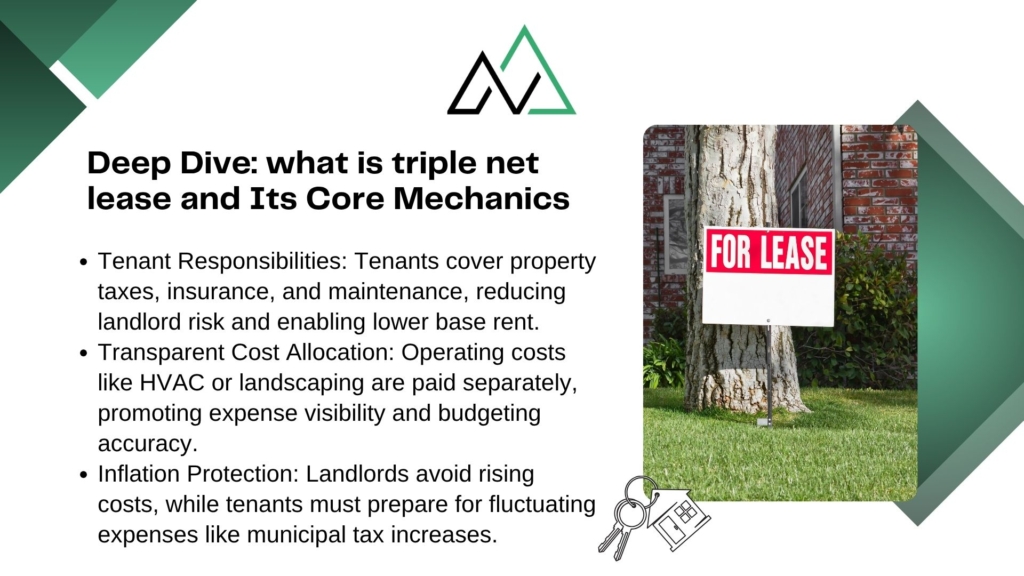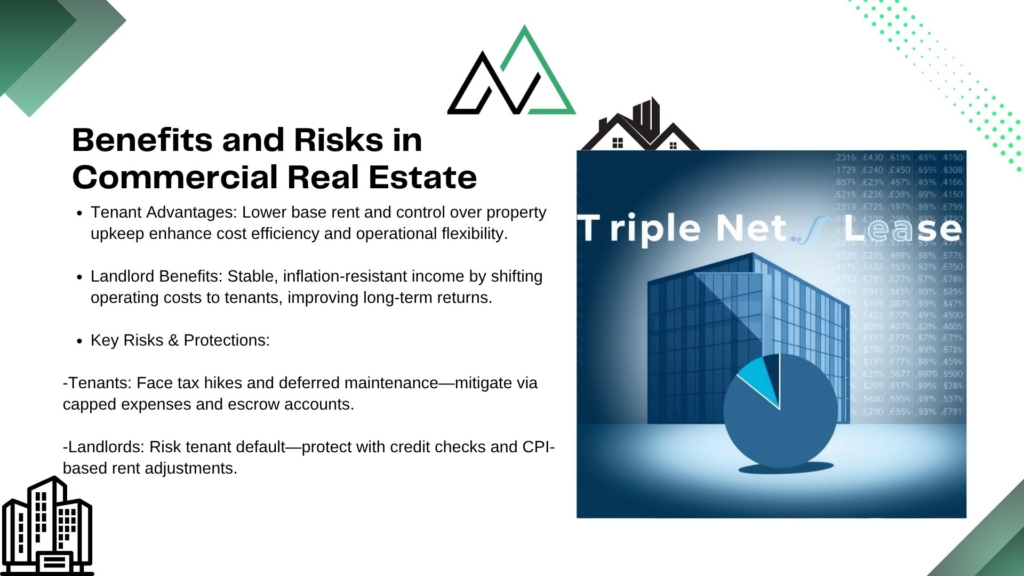In commercial real estate, certain agreements streamline financial responsibilities between landlords and tenants. One popular arrangement shifts property-related costs—like taxes, insurance, and upkeep—directly to renters. This structure, often abbreviated as NNN, allows businesses to manage their occupancy expenses while landlords benefit from predictable income.
Unlike traditional agreements where owners cover building maintenance and utilities, this model reduces base rental rates. Tenants gain control over operational decisions, from landscaping to repairs, in exchange for assuming recurring obligations. For investors, it minimizes unexpected outlays and fosters long-term stability.
New Homes Alberta, a trusted resource for property guidance, highlights how these leases appeal to both parties. Lower monthly rents attract businesses seeking affordability, while landlords avoid fluctuating costs tied to insurance premiums or municipal tax hikes. Understanding these dynamics is critical for first-time buyers and seasoned investors alike.
This article explores negotiation strategies, market examples, and key considerations for navigating such agreements. Whether you’re leasing retail space or evaluating rental income streams, clarity on operating expenses ensures smarter decisions. For personalized advice, contact New Homes Alberta at (403) 305-9167.
Key Takeaways
- Tenants typically cover property taxes, insurance, and maintenance under this arrangement.
- Base rental rates are often lower compared to gross lease agreements.
- Landlords benefit from reduced financial risks and steady income streams.
- Businesses gain flexibility in managing building-related costs.
- Understanding expense allocation is crucial for long-term budgeting.
- Market trends in Canada increasingly favor these agreements for commercial spaces.
Triple Net Lease Fundamentals
Commercial leasing structures determine how financial obligations are shared between renters and property owners. These agreements range from single to triple net models, each with distinct cost-sharing frameworks. Let’s explore their core differences and why they matter for budgeting and operational control.

Definition and Core Components
A triple net lease requires renters to cover three primary costs: property taxes, insurance premiums, and maintenance fees. Base rent payments are lower compared to traditional agreements since tenants assume recurring expenses. This setup allows businesses to manage their occupancy costs directly, from landscaping to HVAC repairs.
Comparison with Single and Double Net Leases
| Lease Type | Tenant Responsibilities | Landlord Responsibilities |
|---|---|---|
| Single Net | Rent + Taxes | Insurance, Maintenance, Utilities |
| Double Net | Rent + Taxes + Insurance | Maintenance, Structural Repairs |
| Triple Net | Rent + Taxes + Insurance + Maintenance | Long-Term Capital Improvements |
For example, a retail store under a triple net agreement might handle parking lot repairs, while the owner focuses on roof replacements. Lower base rents appeal to businesses prioritizing upfront affordability. Investors, meanwhile, gain predictable cash flow with minimal variable costs.
Deep Dive: what is triple net lease and Its Core Mechanics
Effective expense management forms the backbone of sustainable leasing arrangements. In commercial properties, precise cost distribution between parties ensures transparency and long-term viability. Let’s unpack how financial obligations are structured under these agreements.

How Operating Expenses Are Allocated
Tenants in NNN agreements directly handle three recurring costs:
- Property taxes: Municipal levies based on assessed building value
- Insurance premiums: Coverage for fire, liability, or natural disasters
- Maintenance: Routine repairs, landscaping, and system upgrades
Base rent typically excludes these items, creating lower upfront rates. For example, a Calgary retail space might charge $18/sqft annually for rent, while the tenant separately pays $7/sqft for operating costs.
| Expense Type | Annual Cost (5,000 sqft) | Paid By |
|---|---|---|
| Base Rent | $90,000 | Tenant |
| Property Tax | $12,500 | Tenant |
| Insurance | $6,200 | Tenant |
| HVAC Maintenance | $4,800 | Tenant |
The Role of Rent, Taxes, and Maintenance
Landlords calculate base rent by subtracting projected operating costs from market rates. If municipal taxes rise 10%, tenants absorb the increase rather than renegotiating rent. This shields property owners from inflationary pressures but requires tenants to budget flexibly.
A Vancouver office building recently shifted $32,000 in annual sidewalk repairs to its occupant through a net lease amendment. Such adjustments highlight why both parties must review expense clauses annually.
Benefits and Risks in Commercial Real Estate
Balancing financial predictability with operational control defines modern commercial agreements. These arrangements offer unique perks but require careful planning to avoid costly surprises. Let’s examine the dual nature of these contracts through real-world examples and industry insights.

Advantages for Tenants and Landlords
Businesses often favor net leases for their lower upfront rent and autonomy over property upkeep. A Calgary coffee shop owner, for instance, saved 22% annually by managing HVAC repairs directly. Landlords benefit too—passing operating costs to occupants creates stable income shielded from inflation.
| Advantages | Risks | Mitigation Strategies |
|---|---|---|
| Lower base rent | Unexpected tax hikes | Negotiate annual expense caps |
| Tenant-controlled maintenance | Deferred repairs | Require maintenance escrow accounts |
| Predictable landlord income | Tenant bankruptcy risk | Verify credit scores pre-lease |
Potential Pitfalls and Risk Management
Deferred maintenance became a $40,000 headache for a Toronto retail tenant when roof leaks damaged inventory. Clear lease terms specifying repair timelines could have prevented this. Landlords should also monitor municipal tax changes—Edmonton saw a 14% property tax jump in 2023, straining unprepared businesses.
Proactive strategies protect both parties:
- Tenants: Audit historical operating costs before signing
- Landlords: Include rent escalation clauses tied to CPI
- Both: Schedule biannual expense reviews
As one Vancouver property manager notes: “Transparency in cost allocation builds trust—it’s why 68% of our NNN agreements renew automatically.” With proper safeguards, these leases remain powerful tools for commercial growth.
Investment Potential of Triple Net Leases
Investors seeking reliable returns often turn to commercial properties with structured financial frameworks. These arrangements provide predictable cash flow while minimizing hands-on management—a key draw for portfolio diversification.
Stable Income and Capital Appreciation
Long-term agreements spanning 10–15 years reduce vacancy risks, ensuring consistent rental income. A 2023 Canadian market report showed net lease properties delivering average annual returns of 6–8%, outperforming many fixed-income options. Tenants covering operating costs allow owners to focus on strategic growth rather than daily upkeep.
Capital appreciation often follows location value increases. For instance, a Toronto retail property leased to a national pharmacy chain saw its value rise 24% over five years. With tenants handling maintenance and repairs, investors benefit from asset growth without micromanaging expenses.
1031 Exchange and Tax Deferral Benefits
The 1031 exchange lets investors defer capital gains taxes by reinvesting proceeds into similar properties. This strategy works seamlessly with net leases, as their stable income qualifies them as “like-kind” assets under Canadian tax guidelines. By rolling profits into a new commercial building, you preserve liquidity for future ventures.
“Deferring taxes through exchanges can amplify compounding growth,” notes Calgary tax advisor Marie Dubois. “One client reinvested $2.1 million from a sold office complex into a triple-net retail portfolio, preserving $420,000 in deferred taxes.”
Negotiation and Cost Calculation Strategies
Successful agreements in property leasing hinge on transparent negotiations and precise financial planning. Whether you’re a business securing retail space or an investor expanding your portfolio, aligning expectations upfront prevents disputes down the line.
Determining Base Rent and Expense Escalation
Base rent in net lease agreements often starts with market rates minus projected operating costs. For example, a 2,500 sqft Edmonton office space might benchmark at $24/sqft annually. Subtract $9/sqft for taxes, insurance, and maintenance to arrive at a $15/sqft base rate.
Escalation clauses should cap annual increases at 2–3% or tie adjustments to inflation metrics like Canada’s Consumer Price Index. A Winnipeg landlord recently avoided disputes by linking rent hikes to municipal tax increases, ensuring fairness for both parties.
Evaluating Tenant Creditworthiness and Lease Terms
Tenant stability directly impacts risk. Review credit scores, debt-to-income ratios, and business longevity. A national retailer with AAA credit might secure a 12-year lease, while startups may face shorter terms or escrow requirements for repairs.
| Credit Tier | Lease Term | Security Deposit |
|---|---|---|
| Excellent (750+) | 10–15 years | 1 month rent |
| Fair (650–749) | 5–7 years | 3 months rent |
| Poor ( | 1–3 years | 6 months rent |
Avoid estimation pitfalls by auditing historical expense data. One Calgary investor saved $18,000 annually by comparing utility bills across similar properties. Clear lease language specifying repair timelines and cost ceilings further reduces ambiguity.
Pro tip: Partner with local experts like New Homes Alberta to navigate regional tax variations and zoning laws. Their team helped a Red Deer investor negotiate 22% lower insurance premiums through bundled policy discounts.
Triple Net Leases in Different Market Scenarios
Commercial agreements adapt to market demands through varied tenant configurations. Single-tenant and multi-tenant structures offer distinct advantages depending on economic conditions and investor priorities. Let’s explore how these models perform across shifting landscapes.
Risk Distribution and Operational Dynamics
Single-tenant leases involve one business occupying an entire property. National brands like Tim Hortons often use this model for drive-thru locations, handling all maintenance and taxes. Investors enjoy predictable income but face higher vacancy risks if the tenant leaves.
Multi-tenant properties, like Edmonton’s Commerce Place office tower, spread risk across several occupants. If one business vacates, others continue paying rent. However, coordinating repairs and expense allocations becomes more complex. Landlords may manage common areas while tenants handle unit-specific costs.
| Lease Type | Tenant Count | Risk Distribution | Investor Appeal |
|---|---|---|---|
| Single-Tenant | 1 | Concentrated | Simplified management |
| Multi-Tenant | 2+ | Diversified | Lower vacancy impact |
Calgary’s Deerfoot Meadows retail park demonstrates multi-tenant benefits. When a fitness center closed in 2023, remaining shops covered 83% of the property’s income. Investors favoring stability often blend both models in their portfolios.
Strategic Selection for Market Conditions
Key factors influence which structure performs best:
- Location: Prime urban areas suit multi-tenant setups due to diverse tenant demand
- Tenant stability: Established corporations justify single-tenant investments
- Economic cycles: Recessions increase multi-tenant appeal through risk mitigation
“Diversification protects against localized downturns,” notes Vancouver investor Raj Patel. “Our Winnipeg industrial portfolio uses 60% multi-tenant net leases to balance cash flow.” Analyze local vacancy rates and industry trends before committing to either model.
Conclusion
Navigating commercial agreements requires balancing financial foresight with operational flexibility. For tenants, assuming responsibility for taxes, insurance, and upkeep often means lower base rents and direct control over maintenance standards. Landlords benefit from reduced variable costs and predictable income streams, particularly in long-term arrangements.
These contracts carry risks if expense projections prove inaccurate or market conditions shift. Careful negotiation of escalation clauses and repair timelines minimizes disputes. Investors should analyze tenant creditworthiness and local tax trends before committing to lease terms.
Whether expanding a business portfolio or securing retail space, informed decisions hinge on understanding cost allocations. New Homes Alberta offers tailored guidance for navigating these agreements in Canada’s dynamic real estate markets. Reach out at (403) 305-9167 to explore strategies aligned with your financial goals.
Proactive planning transforms commercial real estate challenges into opportunities. With clarity on expense structures and market dynamics, both renters and property owners can build sustainable, profitable partnerships.
FAQ
How does a triple net lease differ from single or double net agreements?
In commercial real estate, tenants in a triple net (NNN) lease cover property taxes, insurance, and maintenance costs, in addition to rent. Single net leases require tenants to pay only property taxes, while double net agreements include taxes and insurance. This structure shifts more financial responsibility to tenants compared to other lease types.
What expenses do tenants typically handle under this model?
Tenants manage three primary operating expenses: property tax payments, building insurance premiums, and upkeep costs like repairs, landscaping, and utilities. Capital expenditures for major structural upgrades, however, often remain the landlord’s responsibility unless negotiated otherwise.
Why do landlords favor NNN leases for retail or industrial spaces?
Landlords benefit from predictable income with minimal overhead, as tenants directly handle variable costs like tax increases or HVAC repairs. This arrangement reduces administrative burdens and provides stable cash flow, particularly for investors prioritizing passive income in commercial real estate.
Can tenants negotiate caps on operating cost increases?
Yes. Savvy negotiators often include expense escalation clauses to limit annual increases in property taxes or insurance. For example, a 3% annual cap prevents unexpected spikes from eroding profit margins, balancing risk between both parties.
How do 1031 exchanges apply to NNN investments?
Investors using triple net properties in 1031 exchanges can defer capital gains taxes by reinvesting proceeds into similar assets. This IRS provision supports portfolio growth while maintaining income streams from creditworthy tenants like national retail chains.
What red flags should investors check in tenant financials?
Review credit ratings, debt-to-income ratios, and business longevity. For instance, a tenant with a BBB+ credit rating and 15+ years in operation presents lower default risk than a startup without audited financials.
Are single-tenant NNN properties riskier than multi-tenant buildings?
Single-tenant assets carry higher vacancy risk but often offer longer lease terms (10-25 years) with reputable brands. Multi-tenant spaces diversify income sources but require more management. Investors balance these factors based on risk tolerance and market conditions.





